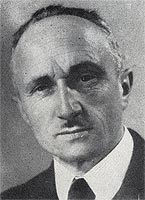
 Paul Daum, born on October 28, 1888, in Nancy, belonged to an old Lorraine family that, since 1871, demonstrated its attachment to France by leaving their homeland to settle in Nancy, where the current Glassworks was founded in 1875.
Paul Daum, born on October 28, 1888, in Nancy, belonged to an old Lorraine family that, since 1871, demonstrated its attachment to France by leaving their homeland to settle in Nancy, where the current Glassworks was founded in 1875.
After studying at the high school and the Chemical Institute of Nancy, Paul Daum joined the family glassworks in 1911. He received his technical and artistic training from his brother Jean (who died in Verdun in 1916) and his uncle Antonin Daum, whose fertile imagination greatly influenced the art of glassmaking. Mobilized in 1914, Paul Daum returned from the war as a squadron commander with the Legion of Honor and five citations.
In 1937, he was appointed head of the Syndicate Chamber of Crystal and Glassware of the East, where he sought remedies to maintain the handmade glass industry, preserving their creative originality alongside mechanical glassware. Since 1925, he exhibited at the Salon des Artistes Décorateurs and Salon d'Automne, which dedicated a retrospective to him in 1947. He participated in numerous exhibitions abroad, particularly at the 1939 New York International Exhibition.
Mobilized in 1939 as an aviation colonel, he was demobilized in November 1940 and settled in Paris, where he joined the Resistance network. Arrested by the Gestapo in his office on Rue Paradis in February 1943, he was sent to Fresnes prison and then to the reprisal camp in Sarrebrück-Neue Brem, where he succumbed in February 1944.
He was posthumously promoted to the rank of Commander of the Legion of Honor on July 7, 1945. The life and activities of glass artist Paul Daum fall exactly between the two World Wars. Although too young before 1914 to be involved in the great movement of the School of Nancy with Prouvé, Majorelle, and Gallé, when he returned to glassmaking, he played a crucial role in returning to a healthier concept of glass art, as the flourishing and naturalistic style with overlapping colored glasses, added decorations, and intricate and delirious shapes fell into decline.
From 1925, a reaction emerged with the sobriety of forms, transparency experiments, and the use of monochromatic or white glass. This will was also evident in tableware and decorative glassware. From 1930 to 1940, Paul Daum created objects with sturdy and well-balanced forms, stripped of ornamentation, in thick white glass, deeply acid-etched with restrained linear decorations. He exclusively used blown and turned glass. The work of glass artist Paul Daum is marked by the exceptional quality of the man whom two wars turned into a hero and then a martyr. His impeccable taste and in-depth knowledge of the craft influenced the evolution of glass and paved the way for new directions. His professional and managerial role significantly contributed to the growth and perpetuity of the craft.
When thinking of Paul Daum, one cannot separate the artist from the man, as someone once said, "It is difficult to explain Paul Daum: if we want to evoke him, it can only be by closing our eyes; the flame and movement cannot be described with words."
This tribute seems to apply, through a remarkable and moving encounter, to his art and his craft, to the molten mass of glass, bursting like a flame, and to which rotation - movement - imparts the pure forms he sought, which today sometimes take on the rhythm and clear momentum of the flame.
SOURCES : MOBILIER ET DECORATION N° 1 DE 1954